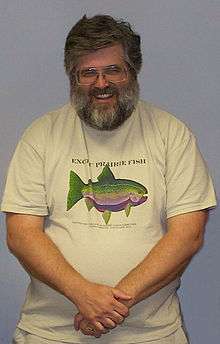Christopher G. Atkeson
Christopher Granger Atkeson (born 1959) is an American roboticist and a Professor at the Robotics Institute and Human-Computer Interaction Institute at Carnegie Mellon University (CMU).[1] Atkeson is known for his work in humanoid robots, soft robotics,[2] and machine learning, most notably on locally weighted learning.[3]
Christopher G. Atkeson | |
|---|---|
 | |
| Born | 28 May 1959 |
| Nationality | American |
| Alma mater | |
| Spouse(s) | Jessica Hodgins |
| Scientific career | |
| Fields | Robotics and Machine Learning |
| Institutions |
|
| Thesis | Roles of knowledge in motor learning (1986) |
| Doctoral advisor | Emilio Bizzi |
Early life and education
Atkeson graduated summa cum laude from Harvard University in 1981 with an A.B. in Biochemistry. He received his S.M. degree in Applied Mathematics in the same year, also from Harvard. He then attended the Massachusetts Institute of Technology and received his PhD in Brain and Cognitive Science from them in 1986, advised by Emilio Bizzi.[4]
Career
Before joining the faculty at CMU in 2000, he was an Assistant, then Associate Professor in the department of Brain and Cognitive Sciences at MIT from 1986–1993. He was also an Associate Professor at the College of Computing, Georgia Institute of Technology from 1994–2000.[5]

Atkenson's work in soft robotics helped influence production on the 2014 Disney film Big Hero 6, and he consulted with the film's production team on the design of Baymax.[7]
Honors and awards
- National Science Foundation Engineering Initiation Award, 1987–1988.
- National Science Foundation Presidential Young Investigator Award, 1988–1993.
- W. M. Keck Foundation Assistant Professorship in Biomedical Engineering, 1988–1990.
- Alfred P. Sloan Research Fellow, 1989–1991.
- W. M. Keck Foundation Associate Professorship in Biomedical Engineering, 1990–1991.
- Teaching Award from the MIT Graduate Student Council, 1990.
- Edenfield Faculty Fellowship Award, 1995.
- Elected by faculty to College of Computing Dean's Advisory Committee, 1995–1996, 1996–1997.
- Finalist, Best Paper Award, ICRA 2000.
Personal life
Atkeson is married to Jessica Hodgins,[8] Professor of Computer Science and Robotics at CMU,[9] and former Director of Disney Research, Pittsburgh.[10]
References
- "Christopher Granger Atkeson - Google Scholar Citations". scholar.google.com. Retrieved 2018-03-09.
- Hardy, Quentin (2015-04-14). "The Robotics Inventors Who Are Trying to Take the 'Hard' Out of Hardware". The New York Times. ISSN 0362-4331. Retrieved 2016-08-15.
- Atkeson, C.G.; Moore, A.W.; Schaal, S. (1997). "Locally weighted learning". Artificial Intelligence Review. 11 (1): 11–73. doi:10.1023/A:1006559212014.
- "PDS SSO". library.mit.edu. Retrieved 2018-03-09.
- "Chris Atkeson's Home Page". www.cs.cmu.edu. Retrieved 2018-03-09.
- Ulanoff, Lance (7 November 2014). "'Big Hero 6' star Baymax was inspired by a real robot". Mashable. Retrieved 20 January 2019.
- Trimboli, Brian (Nov 9, 2014). "CMU's soft robotics inspire Disney's movie Big Hero 6 - The Tartan". The Tartan. Carnegie Mellon University. Retrieved 2016-08-15.
- "Audrey Hodgins". Retrieved 2018-03-09.
- University, Carnegie Mellon. "QoLT Center - QoLT Center - Carnegie Mellon University". www.cmu.edu. Retrieved 2018-03-09.
- "Alumni - Disney Research". Disney Research. Archived from the original on 2018-03-10. Retrieved 2018-03-09.